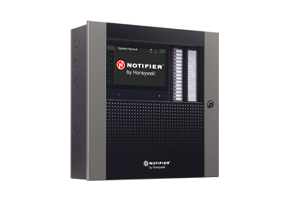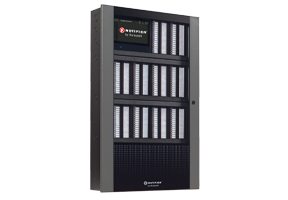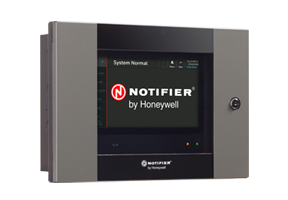TM-8 Transmitter and Relay Module for INSPIRE

The TM-8 module has eight programmable relays:
- Four Low-current
- Four High-current
It can also provide Remote Station Service with Three (3) isolated reverse polarity outputs OR Fire Municipal Box trip.
Communication between the FACP or NCD and these panel modules is accomplished over a power-limited, two-wire serial interface called the AIO Bus and can be connected to either the main or local bus on the module. These modules use a serial communication interface, and may be located up to 6,000 feet from the panel.
Power for the TM-8 is provided via a separate power-limited power loop from the control panel or an external power supply which is inherently supervised by these modules (loss of power results in an annunciator communication failure at the control panel).
The N16 FACP or the NCD supports a maximum of 80TM-8 per node. Up to 10 TM-8s can be configured as routers with each router supporting up to15 TM-8 peripheral modules.
The TM-8 modules are designed to mount in standard option module positions on a variety of chassis compatible with cabinet series CAB-5 and CAB-4, or on the back wall of ABB-1, ABB-2, and NBB-2 behind door-mounted equipment.
Features & Benefits:
- Customizable 80 character Primary label per panel module
- On each TM-8 module in a system, use either the three reverse-polarity outputs (alarm, trouble, and supervisory) or the fire municipal box trip
- Mounts on CHS Series chassis and in panel module locations in CAB 4 and CAB 5 and in the annunciator boxes
- Connected to Internal AIO bus when mounted within FACP enclosure. Connected to External AIO Bus when mounted outside FACP enclosure
- The power run to the module need not contain a power supervision relay since loss of power or communication is inherently supervised through AIO communication bus
- Diagnostic LEDs: green for Power, AIO bus Data Reception and Data Transmission status; yellow for Trouble
- Can be configured as Router or Peripheral using VFT
- Out of the three reverse polarity outputs, Remote Station Supervisory circuit can be reprogrammed for other functions using the panel programming tool
- Remote Station Alarm circuit provides the option to combine trouble indication on the Alarm contact
- Programmable participation in Trouble Delay for AC fail for Remote Station Service
- Programmable participation in Alarm Delay for PAS for the Remote Station Service and Masterbox Trip
- Programmable option to cancel alarm indication when signals are silenced for remote station and municipal box trip
- Total of 8 programmable Form-C Relays:
- Four low-current relays
- Four higher-current relays
- The high current relays can also be used to switch inductive loads (0.35PF)
- The Relay 1 is pre-dispositioned to be a fail safe trouble indication but can be reprogrammed
- Each of the 8 relays can be mapped to activate with a local or network
- Event condition (i.e. fire, CO, supervisory, etc.)
- Activation of a point (i.e. detector, module, PAM, Speaker, BELL)
- Activation of a zone (general zone, logic zone, releasing zone states, special function zone)
- Isolated 24 V for reverse-polarity outputs
- Remote station Disconnect mechanism can be initiated from the panel display. It provides a means for inhibiting alarm status changes, which cause trouble indication for unit at the Fire Alarm Control Panel (FACP). Operation of the disconnect mechanism will also create a trouble condition on the reverse-polarity output circuits or the master box trip
Specifications
The TM-8 module has Eight programmable relays
- Four Low-current Relays 1-4 (TB3-TB6)
- Maximum switched current (resistive): 2A @ 30 VDC
- Four High-current Relays 5-8 (TB7-TB10)
- Maximum switched current (resistive):
- 10A @ 28V DC
- 12A @ 125 VAC
- 6A @ 250 VAC
- 5A @ 277 VAC
- Maximum switched current (Inductive, 0.35 PF):
- 2A @ 28V DC
- 4A@ 125 VAC
- 2A @ 250 VACRequires 24 VDC, May be powered by 24 VDC from the panel or by remote power supplies
- Maximum switched current (resistive):
Microprocessor-controlled electronics, fully supervised
Uses a serial interface and may be located at distances of up to 6,000 feet (1,828.8 meters) from the panel.
LISTINGS & APPROVALS:
- UL Listed: S635
- FM approved: FM23FPUS0095
- CSFM: 7165-0028:0516
- City of Chicago approved: Class1, Class 2
- FDNY COA#001761
- Certified for Seismic applications in accordance with IBC 2024 : VMA-45894-01C
- OSHPD Approved : OSP-0072
Resources
Basket Size :
0 MB out of 50 MB
| Document Name | Asset Type | Type & Size | Modified Date | |
|---|---|---|---|---|
| TM-8 Datasheet | Data Sheets | pdf | 9.82 MB | 11/15/2024 |




